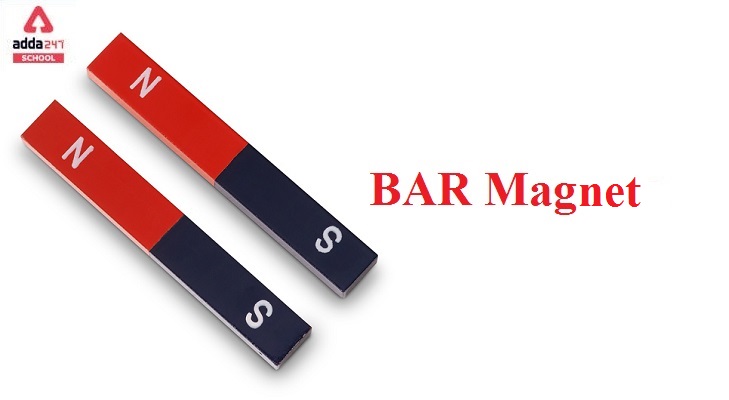What is Bar Magnet
A bar magnet is a type of permanent magnet that is shaped like a rectangular or cylindrical bar. It is one of the simplest and most common types of magnets. Bar magnets have two distinct poles, a north pole, and a south pole, just like the Earth’s magnetic field.
Bar Magnet Uses in Laboratory
Bar Magnet – Uses and Properties: A magnet is anything that generates a magnetic field. This magnetic field is invisible, but it is responsible for a magnet’s most notable property, a force that attracts or repels other ferromagnetic materials such as iron, steel, nickel, cobalt, and other magnets.
A bar magnet is a rectangular portion of an object with permanent magnetic properties formed of iron, steel, or any other ferromagnetic substance or ferromagnetic composite. It has two poles, one north and one south, and when suspended freely, the magnet aligns itself so that the northern pole points to the earth’s magnetic north pole.
Read About: Ozone Hole
Magnet Uses in Laboratory
Magnets have a variety of uses in laboratory settings. Here are some common applications:
Separation of Magnetic Materials: Magnets are often used to separate magnetic materials from non-magnetic materials. For example, in chemistry labs, they can be used to remove magnetic impurities from a mixture.
Stirring and Mixing: Magnetic stirrers are widely used in laboratories. They consist of a magnetic bar placed in a container with a magnetic field underneath. By rotating the magnetic field, you can stir liquids without the need for a mechanical stirrer, reducing the risk of contamination.
Magnetic Resonance Imaging (MRI): In medical and research laboratories, strong magnets are used in MRI machines to produce detailed images of the internal structures of living organisms, including humans.
Electromagnetic Research: Powerful magnets are used in physics and engineering labs for various research purposes, including studying the properties of materials in strong magnetic fields and conducting experiments in electromagnetism.
Particle Accelerators: In high-energy physics research, particle accelerators use magnets to steer and focus particle beams, such as in cyclotrons and synchrotrons.
Magnetic Particle Inspection: This technique is used in materials testing to detect cracks or defects in materials. A magnetic field is applied, and magnetic particles are used to visualize irregularities.
Magnetic Field Measurement: Magnets and magnetic sensors are used to measure the strength and direction of magnetic fields. This is crucial in various experiments and research involving magnetic phenomena.
Sample Holding and Mounting: In microscopy and spectroscopy, magnets can be used to hold samples or mount specialized equipment securely.
Electromagnetic Separation: Magnetic fields are employed in techniques like electrophoresis and magnetophoresis to separate particles based on their magnetic properties. This is commonly used in biological and chemical research.
Magnetic Storage: Laboratories often use magnetic storage devices like hard drives to store data. These devices rely on the magnetization of tiny areas to represent digital information.
Magnetic Filters: Magnets can be used to filter out impurities or specific particles from a solution or gas stream. This is used in various analytical and purification processes.
Magnetic Field Generation: Lab-scale experiments sometimes require the generation of precise magnetic fields for testing purposes or to simulate specific conditions.
NMR Spectroscopy: Nuclear Magnetic Resonance (NMR) spectroscopy is a technique used in chemistry and biochemistry to determine the structure of organic compounds. It relies on the interaction of atomic nuclei with magnetic fields.
Magnetic Traps: In some biological and chemical applications, magnetic traps are used to manipulate and study microscopic particles or cells.
Education and Demonstration: Magnets are often used in educational laboratories to demonstrate fundamental principles of magnetism and electromagnetic phenomena.
These are just a few examples of how magnets are used in laboratory settings. The specific applications may vary depending on the field of research and the equipment available in a particular laboratory.
Magnet Function in Laboratory
In a laboratory setting, magnets are used for a wide range of purposes and experiments across various scientific disciplines. The function of magnets in a laboratory can be broadly categorized into several areas:
- Magnetic Separation: Magnets are used to separate magnetic materials from non-magnetic substances. This technique is commonly employed in chemistry and biology for tasks like purifying magnetic nanoparticles, isolating specific biomolecules, or removing unwanted magnetic impurities from a sample.
- Magnetic Stirring: Magnetic stirrers are commonly used in chemistry laboratories. A magnetic stir bar (usually coated with PTFE or other inert materials) is placed in a container with a liquid sample. Beneath the container, a magnetic stir plate generates a rotating magnetic field, causing the stir bar to spin and mix the contents of the container without the need for a mechanical stirrer.
- Magnetic Resonance Imaging (MRI): In medical and biological research, powerful magnets are used for MRI scans. These magnets create a strong, uniform magnetic field that interacts with the hydrogen nuclei in the body, allowing for detailed imaging of tissues and organs.
- Magnetic Field Measurement: Magnets are used in laboratories to measure magnetic fields. Devices such as magnetometers or Hall effect sensors can detect and quantify the strength and direction of magnetic fields. This is crucial in various physics and materials science experiments.
- Electromagnets: Laboratories often employ electromagnets, which are magnets generated by passing an electric current through a coil of wire. These can be adjusted in strength by varying the current, and their polarity can be changed by reversing the current direction. Electromagnets are used in physics experiments, particle accelerators, and various industrial processes.
- Magnetic Storage: In some scientific experiments and data storage applications, magnets are used to encode and store information on magnetic media, such as hard drives or magnetic tapes.
- Magnetic Levitation (Maglev): In physics and materials science research, magnets are used to levitate objects using the repulsive force between two magnets with like poles facing each other. This can be used to study the properties of superconductors and magnetic materials.
- Magnetic Field Manipulation: Researchers may use magnets to manipulate the trajectory of charged particles in experiments, such as those conducted in particle accelerators or plasma physics studies.
- Magnetism Studies: Scientists use magnets to study the properties of materials and gain insights into their magnetic behavior. This can involve experiments to measure magnetic susceptibility, investigate magnetic phase transitions, or study magnetic hysteresis.
- Education and Demonstration: Magnets are often used in educational settings to demonstrate basic principles of magnetism and electromagnetism. They are valuable tools for teaching and illustrating scientific concepts.
The use of magnets in a laboratory can vary greatly depending on the specific field of research and the objectives of the experiments being conducted. Magnets are indispensable tools in many scientific investigations, enabling researchers to manipulate, measure, and explore various phenomena related to magnetism and electromagnetism.
Bar Magnet: As an equivalent Solenoid
A solenoid is a type of electromagnet that produces regulated magnetic fields by running an electric current through it. It is a coil with a length greater than its diameter. A bar magnet can be proven as a solenoid by calculating the axial field of a finite solenoid carrying current.
Read About: Global Warming
Bar Magnet in Magnetic field
We can grasp the concept of the magnetic field by performing a task, which will help us understand the notion of magnetic field lines.
- Put some iron filings on a piece of paper.
- Sandwich a bar magnet between them.
- We see that the fillings align when we tap the paper.
Now, take a look at the properties that a magnetic field has:
- Magnetic field lines are imaginary lines that can be drawn along any magnetic substance’s magnetic field.
- Magnetic field lines have particular qualities, such as forming continuous closed loops, as do the magnetic field lines of a magnet.
- The direction of the net magnetic field B at any place is represented by the tangent to the field line.
- The magnitude increases as the number of field lines crossing per unit area increases. Also, the lines of the magnetic field never intersect with one another.
Bar Magnet: Properties
The properties of Bar magnet is as follow:
- At both ends, it has a north pole and a south pole. Even after splitting a bar magnet in half, each portion will have a north pole and a south pole. It doesn’t matter, how many pieces you break it into.
- It has the strongest magnetic force at the pole.
- If a thread is used to suspend this magnet in the air, it will not come to rest until the poles are oriented north-south. This attribute is used by a Mariner’s Compass to determine direction.
- When two bar magnets are positioned near together, their unlike poles attract each other while their like poles repel each other.
- All ferromagnetic materials, such as iron, nickel, and cobalt, are attracted by a bar magnet.
Read About: Biosphere Reserve
Bar Magnets Uses in Real World
- In the laboratory, bar magnets are employed as stirrers for magnetic studies.
- They can also be used in medical operations.
- Magnets are used in electronic devices such as telephones, radios, and television sets.
- Bar magnets are used in a variety of industries for collecting loose metals and preserving the magnetism of other magnets.
What are bar magnets and how do you use them?
A rectangular section of the object is called a bar magnet. Iron, steel, or any other ferromagnetic substance or ferromagnetic composite make up this device.
What are the uses of a bar magnet?
Bar magnets are used to pick up small metallic objects such as metal shavings, nails, and screws, as well as magnetic stirring rods in laboratory applications and refrigerator magnets.
Is a permanent magnet an electromagnet?
An electromagnet is a temporary magnet that generates a magnetic field by passing electric current via a coil coiled around a soft iron core.
What exactly is the distinction between a magnet and a bar magnet?
When an electric current is supplied through wires wound around soft metalcore, an electromagnet is created. When a current flow is interrupted, an electromagnet loses its magnetic.
Which magnet is more powerful: a bar magnet or a horseshoe magnet?
Because of their form, horseshoe magnets are more powerful than bar magnets.









 RBSE Class 10 Model Paper 2026 Out, Down...
RBSE Class 10 Model Paper 2026 Out, Down...
 RBSE Class 12 Model Paper 2026 for Arts,...
RBSE Class 12 Model Paper 2026 for Arts,...
 SLAT Preparation 2026: Tips and Subject ...
SLAT Preparation 2026: Tips and Subject ...














